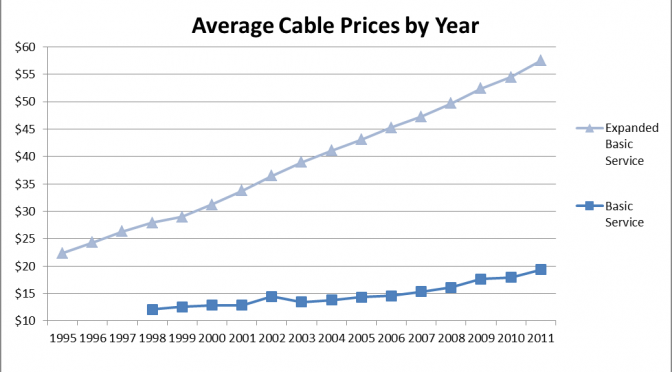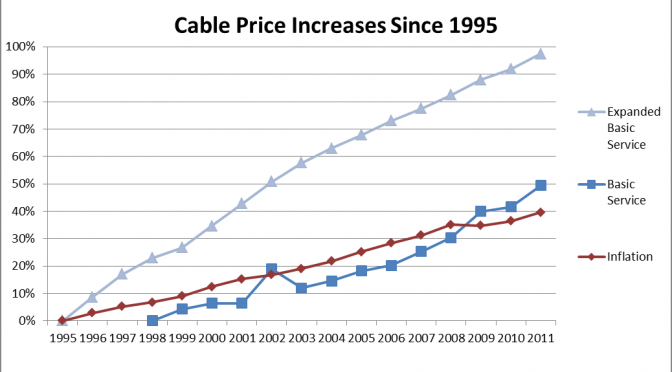I recently dropped ridiculously expensive cable and opted for a combination of a free over-the-air antennae, streaming Netflix, and downloading via a Newsgroup. Having paid internet with no paid TV service is called “cord cutting” and is a major trend among Generation Y. More specifically, non-subscribers fall into two categories – “evaders” (those who have never purchased subscription-based pay TV) or “defectors” (former subscribers who have cut the cord) – and evidently I’m a “defector” (says the middle aged woman who wrote that article).
In not an economist but I do find the cable industry to be a bizarre playing field. Although not a monopoly at the federal level, many areas of the country operate as such because consumers are left with only a single viable option for cable service (I’ve written about one such monopoly in the past). However, unlike other near monopolies, there is a free alternative to cable which provides (almost) similar quality (although much fewer channels). Imagine if DeBeers, in their monopoly of the diamond market, began giving grade “S” diamonds to the public for free. Would anyone pay egregious amount of money for grade D diamonds? How much better would a diamond need to be for anyone to decide to pay anything for it? Similarly, how much better does MTV need to be for me to pay $70 a month versus settling with HD quality NBC, CBS, ABC, Fox, and PBS for free?
Yet cable didn’t used to cost three times more than a utility bill. The Federal Communications Commission (FCC) lists average costs of cable dating back to 1995 (unfortunately I couldn’t find consistent earlier data):
| Year | Basic Service |
Expanded Basic Service | ||
| Price | # Channels | Price/Channel | ||
| 1995 | – | $22.35 | 44 | $0.60 |
| 1996 | – | $24.28 | 47 | $0.61 |
| 1997 | – | $26.31 | 49 | $0.63 |
| 1998 | $12.06 | $27.88 | 50 | $0.65 |
| 1999 | $12.58 | $28.94 | 51 | $0.65 |
| 2000 | $12.84 | $31.22 | 55 | $0.66 |
| 2001 | $12.84 | $33.75 | 59 | $0.60 |
| 2002 | $14.45 | $36.47 | 63 | $0.66 |
| 2003 | $13.45 | $38.95 | 68 | $0.65 |
| 2004 | $13.80 | $41.04 | 70 | $0.66 |
| 2005 | $14.30 | $43.04 | 71 | $0.62 |
| 2006 | $14.59 | $45.26 | 71 | $0.65 |
| 2007 | $15.33 | $47.27 | 73 | $0.67 |
| 2008 | $16.11 | $49.65 | 73 | $0.68 |
| 2009 | $17.65 | $52.37 | 78 | $0.71 |
| 2010 | $17.93 | $54.44 | 117 | $0.56 |
| 2011 | $19.33 | $57.46 | 124 | $0.57 |
A few definitions according to the FCC:
- Basic Service: The local broadcast stations; public, educational, and governmental access channels; and typically a few additional channels that may be of local, regional, national, or international origin. (required by the Cable Television Consumer Protection and Competition Act of 1992)
- Expanded Basic Service: The combined price of basic service and the most subscribed cable programming service tier excluding taxes, fees and equipment charges
Comparing these prices to inflation of the US Dollar shows that although “Basic Service” (which I don’t believe anyone actually uses) trends similarly with inflation, “Expanded Basic Service” has gotten ridiculous:
A few issues with these prices:
- All of the prices above exclude taxes, fees, and equipment charges. In my experience, these are usually ridiculous so the true cost of cable TV (and its difference from US inflation) is really underrepresented above.
- Although the cost of Expanded Cable has increased at a rate far exceeding cable, the average number of channels available in Expanded Cable has also increased. As a result, the average cost per channel has actually decreased in recent years. In my opinion, however, the percentage of channels actually watched must be at an all time low.


Jenna and I “cut the cord” about 6 months ago. I really don’t miss utility one bit.
I’ve been analyzing this for months. Unfortunately we can’t get antenna reception where we live in Boulder, otherwise that free option would be the choice. My big hangup is live sports, so if an antenna could be combined with just purchasing ESPN, that would be my ideal.
Currently: We have the most basic Comcast cable package (no ESPN) and high speed internet. Cable services only come to $20. A bonus for us is that we were given free HBO months ago for bad service, and we mysteriously still have it for free.
Option 1: Direct TV and Internet package. This was the best price wise, while also including great sports options. Unfortunately the internet provider (century link) was through the phone line and we deemed this too slow.
Option 2: I very much considered hooking up the Sling Box at a family members home who has cable. It seemed complicated, though, if someone was actually watching the TV at that location.
Option 3: I heard Apple is trying to build a pay per channel service?
Option 4: Nothing. We go with this every few months when Comcast doesn’t feel like renegotiating our contract
There’s a book focused on wired cable, wireless broadband, and content distribution markets.
http://www.amazon.com/Captive-Audience-Telecom-Industry-Monopoly/dp/0300153139
I’ve only started to work through the book.
The book makes the claim there are insufficient competitors in the internet service provider market, with which I would tend to agree.
There have been regulator based solutions to this issue in other countries, e.g. Britain.
A cursory search for British ISPs gives a website listing the most popular:
http://www.ispreview.co.uk/review/top10.php
The bandwidth available to the end user is much better and the cost / month is comparatively low, even after converting from pounds to dollars.